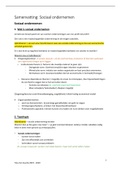Summary
Summary for LTS Exam (weeks 1-10)
- Course
- Institution
This summary shows the red line throughout the course and contains all areas and topics covered + examples and presentation notes. The document also contains all the readings for this course that are very relevant for the exam. The topics covered are: Week 1 - Introduction & Technology as a re...
[Show more]












